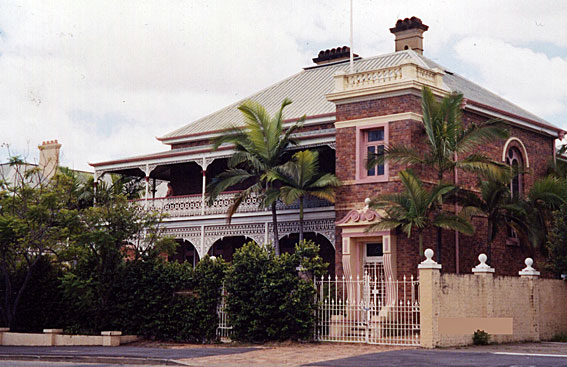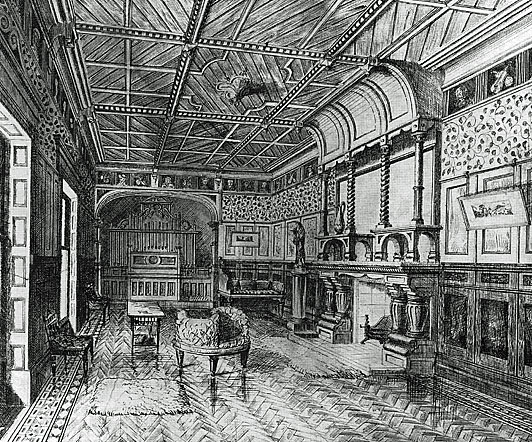
'Leckhampton' in Shafston Avenue, Kangaroo Point
[Photograph by Geoffrey Cox (January 2004)]

'Leckhampton' in Shafston Avenue, Kangaroo Point
[Photograph by Geoffrey Cox (January 2004)]
Historical and Technical Documentation by Geoffrey Cox
© OHTA 2011, 2014 (last updated October 2014)
'Leckhampton', the residence of Charles S. Snow, was designed in 1889-90 by the Scottish-born architect, Alexander B. Wilson (1857-1938), who had emigrated at a young age to Brisbane, where he set up his own architectural practice in 1884.1 The house still stands proudly in the much altered landscape of Shafston Avenue, not far from Main Street, Kangaroo Point.
The following details concerning Charles S. Snow were recorded in a conversation between Snow's widow and the present author in 1974:
Charles Smethurst Snow was for many years organist of St Mary's Anglican Church, Kangaroo Point. A plaque in the church records that he formed the first Scout group in Queensland, reportedly as a result of ill treatment received by his choirboys at the hands of local lads, whom he then encouraged to join his scout group along with the others.
A watchmaker by profession, Snow built an organ in the family residence at 59 Shafston Avenue, Kangaroo Point, a two-story brick house not far from St Mary's. The organ was located in the music room of the house upstairs, and was pumped from downstairs by Snow's younger brother.
C.S. Snow was not married until after the First World War. The instrument was built before the war, probably around 1909, the parts being imported by Snow from England. It had two manuals and pedals, and was quite large - reportedly 'around the size of the original one at St Andrew's, South Brisbane.'
C.S. Snow crashed badly during the First World War, and his younger brother reportedly sold the organ without his knowledge, before the war had ended (around 1917) to the West End Methodist Church.
Snow was the nephew of W.J. Snow of Toowoomba, who also reportedly built his own organ.2
The description of Snow's organ in the music room at Shafston Avenue makes for interesting comparison with a drawing of an 'unidentified interior' by the architect, A.B. Wilson, who had designed Snow's residence.

Drawing by A.B. Wilson of an unidentified interior (undated),
courtesy of Mr Blair Wilson, reproduced in Watson & McKay,
Queensland Architects of the 19th Century (1994), p. 208
According to the account of his widow, Snow's organ was not built until around 1909, but Wilson may have incorporated an organ into a drawing for Snow, either when or after the house was built.
The original organ at St Andrew's Anglican Church, South Brisbane, to which Mrs Snow apparently referred, was built by J.W. Walker & Sons in 1884, comprising 16 stops spread over two manuals and pedals. This would be large for a residence organ, although it is possible that Mrs Snow was referring to the B.B. Whitehouse & Co. organ at Holy Trinity Anglican Church, Wooloongabba, built in 1912, probably comprising around 8-10 stops. This church was sometimes also described as being in 'South Brisbane'.
It is virtually impossible that Snow's organ was sold to the Methodist Church, West End, as Mrs Snow suggested, as the history of the various instruments at that location has been fully documented.
The organ-building activities of Charles S. Snow's uncle, W.J. Snow in Toowoomba, took place around 1922. He purchased various parts for an organ from Whitehouse Bros in that year,3 although a letter written by Snow to George Fincham & Sons of Melbourne in 1921 suggests that he was installing an organ that had been kept in storage in Melbourne from around 1914.4 W.J. Snow's organ was a small single-manual instrument that was removed to the Methodist Church, Oakey, around 1930, and has subsequently been broken up.5 This was clearly not the same instrument as the one at Kangaroo Point.
The subsequent fate of Charles S. Snow's organ at Kangaroo Point, and all other details concerning it, remain unknown.
_________________________________________________________________________
1 Donald Watson & Judith McKay, Queensland Architects of the 19th Century: A Biographical Dictionary (Brisbane: Queensland Museum, 1994), pp. 208-10. 'Leckhampton' is described by Watson & McKay (presumably in error) as being built for 'Charles William Snow'.
2 Personal communication to G. Cox from Charles Snow's widow, Mrs U.C. Snow of 3 St Baliol Street, Kenmore, 1974.
3 Whitehouse Bros Ledger (1922-1940), p. 109.
4 Letter from W.J. Snow to George Fincham & Sons, June 1921, cited by Graeme Rushworth.
5 Personal communications to G. Cox from Walter Emerson, February 1974, and from H.W. Jarrott, February 1974 and January 2006.